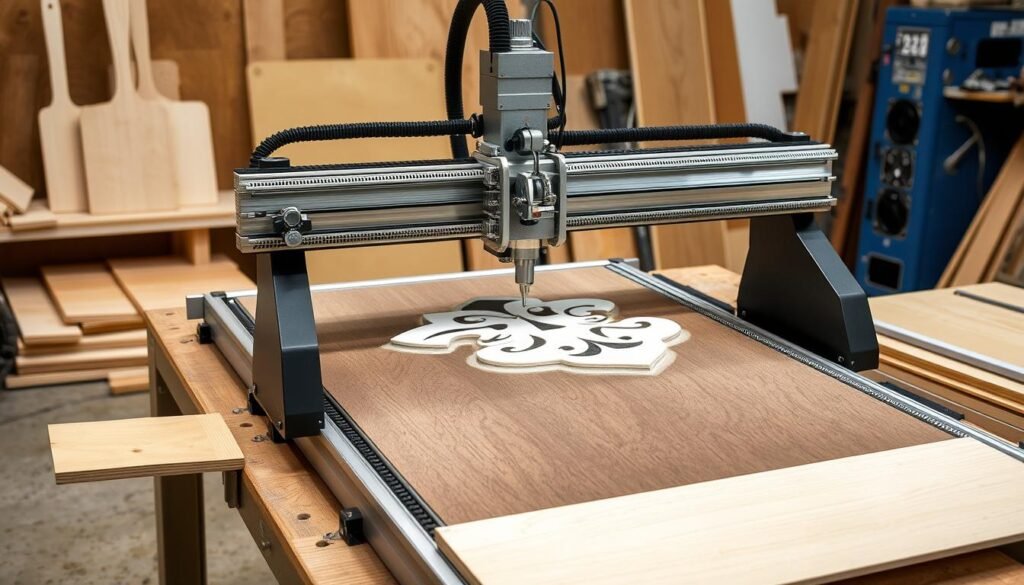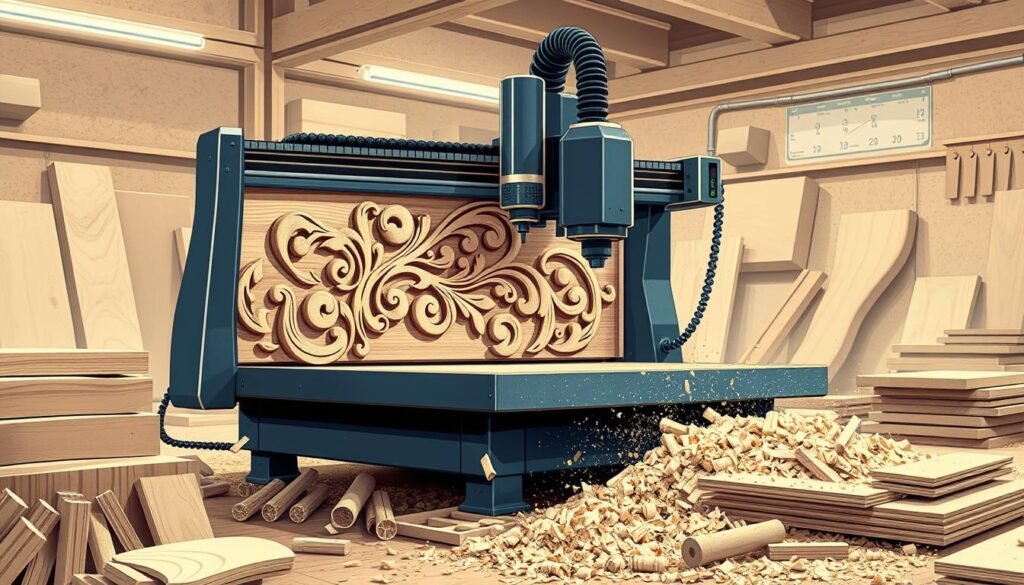CNC router machines use computer numerical control to cut and shape materials with precision. They play a key role in modern manufacturing. This technology makes CNC machining efficient and precise, essential in many industries.
Router technology helps manufacturers create complex designs and patterns easily. This streamlines their production processes.
CNC router machines are versatile, working with materials like wood, plastic, metal, and foam. They achieve high precision and accuracy thanks to computer numerical control. This makes them perfect for detailed designs and complex shapes.
Because of this, CNC machining is vital in woodworking, metal fabrication, and sign making. It’s a key part of many manufacturing processes.
Understanding What is CNC Router Machine
CNC router machines have changed how we make things, like wood and metal. They are key tools in today’s factories. They help make complex designs and precise cuts easily.
Basic Definition and Core Functions
A CNC router machine is a computer-controlled device. It uses cutting tools to shape and design materials. It can cut, drill, and engrave, making it useful in many industries.
History and Evolution of CNC Routing
The first CNC machines came out in the 1960s. Over time, CNC technology has grown. It now uses better computer software and hardware, making it more precise and efficient.
Key Components of a CNC Router
A CNC router has a control system, drive system, and cutting tools. The control system guides the machine. The drive system gives it the power and speed needed for cutting.
Some important features of CNC routers include:
- Precision cutting and shaping capabilities
- High-speed processing for increased productivity
- Advanced software for complex design creation

CNC routers are vital in making things, like wood and metal. They help create detailed designs and precise cuts easily.
| Industry | Application |
|---|---|
| Woodworking | Furniture making, cabinetry, wood carving |
| Metal Fabrication | Sheet metal cutting, metal engraving, metal shaping |
The Working Principles Behind CNC Router Technology
CNC machining is key in today’s manufacturing. Router technology is a big part of it. It uses computer systems to control the machine. This lets it cut and shape materials with great precision.
First, designers make a digital model of the product using CAD software. Then, this model is turned into instructions for the CNC machine. This is how it can cut and shape the material accurately. Precision is very important in CNC routing because it affects the product’s quality.
Some important parts of CNC router technology are:
- Precision cutting and shaping of materials
- Use of CAD/CAM software for design and execution
- Computer numerical control systems for guiding the machining process
CNC machining has changed the manufacturing world. It makes making complex products easier and faster. With router technology, businesses can make high-quality products that customers want.

To sum up, knowing how CNC router technology works is vital for those in manufacturing. Understanding CNC machining and router technology lets people make innovative products. These products can help businesses succeed.
| Technology | Description |
|---|---|
| CNC Machining | Precision cutting and shaping of materials |
| Router Technology | Computer numerical control systems for guiding the machining process |
| Manufacturing Processes | Use of CAD/CAM software for design and execution |
Essential Components of a CNC Router System
A CNC router system has key parts that work together for efficient and precise work. These parts are important in making signs, parts for aerospace, and metal work.
The control software and interface are key to a CNC router’s operation. This software lets users design and program the cutting paths. It also helps monitor and control the machine’s movements. The mechanical parts, like the spindle and drive system, are also vital for the machine’s accuracy and speed.
Control Software and Interface
The control software interprets design files and carries out the cutting operations. It also gives real-time feedback and monitoring. This lets users adjust the machine’s settings as needed.
Mechanical Components
The mechanical parts of a CNC router system include the frame, gantry, and drive system. These parts ensure the machine’s rigidity, stability, and movement for cutting operations.
Cutting Tools and Accessories
Cutting tools and accessories, like router bits and collets, are also key. These tools are made for specific materials, such as wood, metal, and plastic. They are used in sign making, aerospace, and metal fabrication.
In conclusion, the essential components of a CNC router system work together. They make a powerful and versatile tool for manufacturing. By knowing the importance of each part, users can get the best performance and quality in various manufacturing tasks.
Types of Materials Processed by CNC Routers
CNC routers are very versatile machines. They can work with many materials, including wood. They can also handle plastics, metals, and composites. The right tools, speeds, and feed rates are key for each material.
In woodworking, CNC routers can make detailed designs on wood. They can also cut and shape metal sheets. This makes them very useful in many industries, from furniture to aerospace.
Some materials CNC routers can work with include:
- Woods (softwoods and hardwoods)
- Plastics (acrylic, PVC, ABS)
- Metals (aluminum, steel, copper)
- Composites (carbon fiber, fiberglass)
Choosing the right tools and settings depends on the material. For example, woodworking needs different tools than metal work. Knowing how each material works with the CNC router is important for quality results.
CNC routers have changed the manufacturing world. They offer fast, accurate, and efficient work on many materials. They are key for many manufacturers, from woodworking to metal and composite work. Understanding CNC routers helps manufacturers improve their work, leading to better productivity and success.
Common Applications Across Industries
CNC router technology is key in many industries. It makes manufacturing better and products more precise. CNC machining changes how goods are made, from wood to metal.
In woodworking, CNC routers make detailed designs on wood. This tech helps make products fast and well. Metal fabrication uses CNC to cut metal accurately and quickly.
Sign making and advertising also use CNC routers. They make detailed designs on different materials. Aerospace and automotive parts use CNC for precise components.
- Woodworking and furniture manufacturing
- Metal fabrication
- Sign making and advertising
- Aerospace and automotive parts
CNC router technology is vital in many fields. It boosts manufacturing and product quality. Its precision and versatility are key for making high-quality products fast and accurately.
| Industry | Application |
|---|---|
| Woodworking and furniture manufacturing | Creating intricte designs and patterns on wood |
| Metal fabrication | Cutting and shaping metal sheets and plates |
| Sign making and advertising | Creating intricte designs and patterns on various materials |
| Aerospace and automotive parts | Producing complex components with high precision and accuracy |
Benefits of Using CNC Router Machines
Computer numerical control (CNC) router machines have changed manufacturing for the better. They bring many benefits to industries. One big plus is their ability to make products more precise and accurate, leading to better quality.
Using CNC router machines makes production faster and cheaper. They automate tasks, cutting down on mistakes. This means companies can make more products quicker. Plus, CNC routers work with many materials, making them very useful in different manufacturing steps.
Some main benefits of CNC router machines are:
- Increased precision and accuracy
- Improved efficiency and reduced production costs
- Ability to process a wide range of materials
- Enhanced product quality
Adding CNC router technology to manufacturing can really help a company’s success. As the need for top-notch products grows, using CNC routers is key for businesses to stay ahead.
Choosing the Right CNC Router for Your Needs
Choosing a CNC router involves looking at several key factors. You need to understand how CNC machining fits into your production. Also, see how it works with other manufacturing processes.
It’s important to pick the right router technology for your needs. This could be for woodworking, metal work, or other materials. Think about the size of your materials, the power needed, and your budget.
Some things to think about when picking a CNC router include:
- Size and power of the machine
- Budget and expected return on investment (ROI)
- Technical specifications such as spindle speed, axis configuration, and software compatibility
By carefully looking at these factors, you can find a CNC router that fits your needs. It will help you use the latest in router technology for your CNC machining tasks.
| Factor | Consideration |
|---|---|
| Size and Power | Match the machine’s capacity to your material sizes and task requirements |
| Budget and ROI | Evaluate the cost of the machine against possible productivity gains and cost savings |
| Technical Specifications | Make sure the machine’s features match your specific manufacturing needs and applications |
Maintenance and Safety Guidelines
Keeping CNC routers in top shape is key for lasting performance. This is true for many manufacturing tasks, like CNC machining and router tech. A well-kept CNC router means smooth production, less downtime, and better efficiency.
Prevention is key when it comes to maintenance. Daily checks on parts like the spindle, bearings, and tools are a must. Following a set maintenance schedule helps keep everything running right.
Regular Maintenance Schedule
- Daily: Check and clean the machine, inspect cutting tools and replace if necessary
- Weekly: Lubricate moving parts, check and adjust the spindle
- Monthly: Perform thorough cleaning, inspect and replace worn-out parts
Along with regular upkeep, safety rules and best practices are vital. They help avoid accidents and keep the work area safe. This includes wearing safety gear and knowing emergency steps in case of an accident.
Safety Protocols and Best Practices
By sticking to these guidelines, makers can keep their CNC routers safe and efficient. This cuts down on downtime and boosts productivity in tasks like CNC machining and router tech.
| Maintenance Task | Frequency | Importance |
|---|---|---|
| Daily Checks | Daily | High |
| Weekly Lubrication | Weekly | Medium |
| Monthly Cleaning | Monthly | High |
Latest Innovations in CNC Router Technology
The world of computer numerical control (CNC) has made big strides in recent years. A major area of growth is in router technology. This has led to the creation of more complex and precise products.
New advancements in CNC router technology include better control systems and more machining capabilities. These changes also allow CNC routers to work with other manufacturing technologies. This has made CNC routers more capable and efficient.
These innovations bring several benefits, such as:
- Increased precision and accuracy
- Improved productivity and efficiency
- Enhanced flexibility and versatility
The manufacturing industry is always changing, and CNC router technology will likely see more innovations. With the ability to work with other technologies, like computer numerical control systems, the possibilities are endless.
In conclusion, the latest advancements in CNC router technology are changing the manufacturing world. By using new manufacturing processes and router technology, companies can become more efficient and precise. This leads to better competitiveness and success.
Conclusion: The Future of CNC Routing in Manufacturing
CNC (Computer Numerical Control) routing technology has changed the game in manufacturing. It brings unmatched precision, efficiency, and flexibility. Whether it’s fine woodworking or complex metal work, CNC machining is key for today’s makers.
The future of CNC router technology looks bright. Advances in software, automation, and materials will lead to more advanced CNC machines. These will make production smoother, cut down on waste, and allow for more detailed and custom products.
As manufacturing processes keep evolving, CNC routers will play an even bigger part. By adopting this cutting-edge tech, makers can stay ahead, work more efficiently, and meet the industry’s changing needs.
